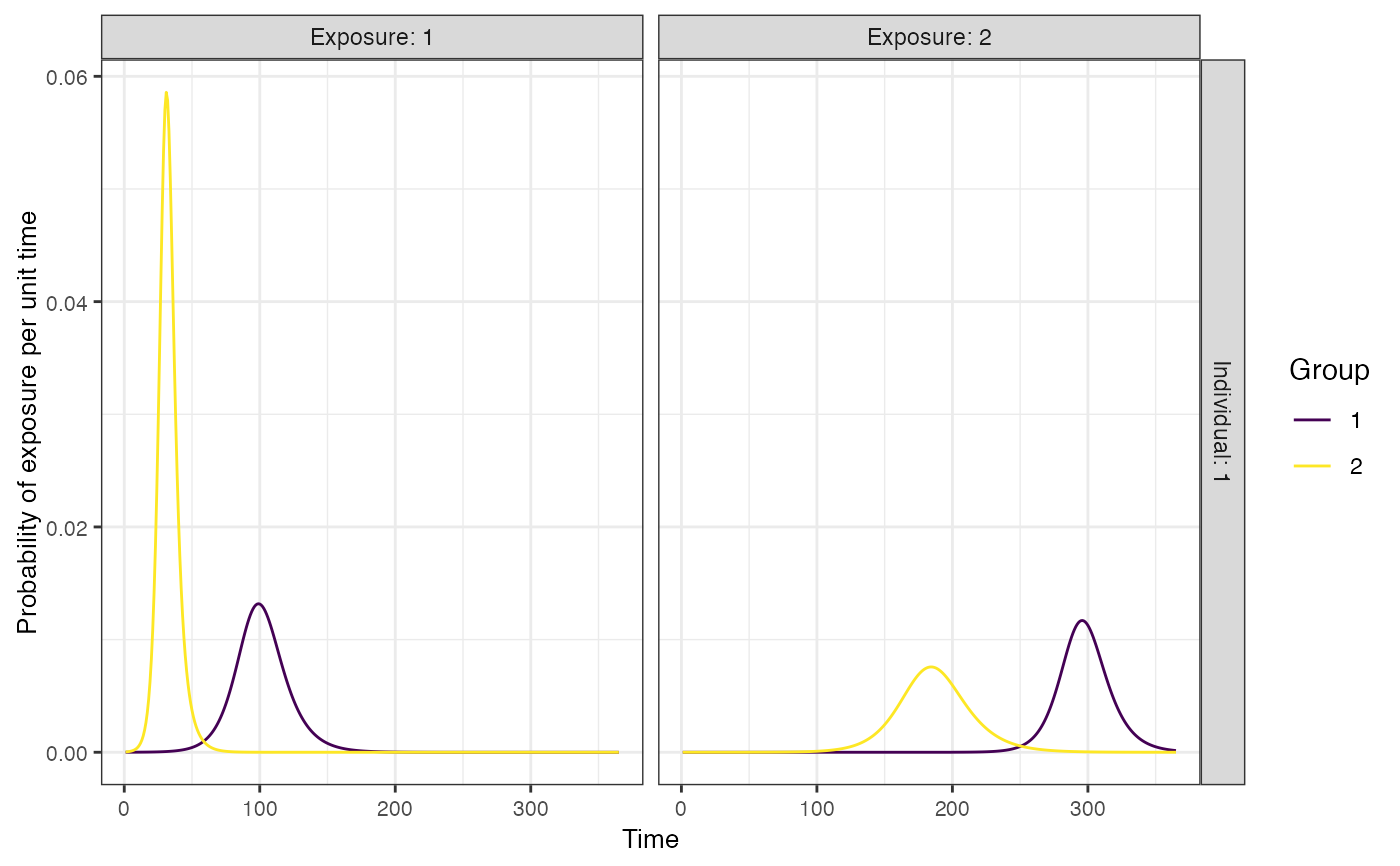Plots the probability of exposure over time for the provided exposure models
Source:R/generate_plots.R
plot_exposure_model.RdPlots the probability of exposure over time for the provided exposure models
plot_exposure_model(
indivs = 1,
exposure_model,
times,
n_groups = 1,
n_exposures = 1,
foe_pars,
demography = NULL,
...
)Arguments
- indivs
(optional) vector of individuals to plot exposure probabilities for. This is important if the
demographytable contains information on more individuals than you wish to plot- exposure_model
A function calculating the probability of exposure given the foe_pars array
- times
Vector of times to solve model over
- n_groups
Number of groups corresponding to
foe_pars- n_exposures
Number of exposure types corresponding to
foe_pars- foe_pars
Generic object containing all parameters needed to solve
exposure_model- demography
A tibble of demographic information for each individual in the simulation. At a minimum this tibble requires 1 column (i) where all individuals in the simulation are listed by row. This is used to calculate the sample population size. Additional variables can be added by the user, e.g., birth and removal times, see
generate_pop_demographyIf not specified, the model will assume that birth time is the initial time point and removal time is the final time point across all individuals- ...
Any additional arguments needed for the models
Value
A ggplot2 object
Examples
## Basic exposure model with demography modifier
times <- seq(1,120,1)
n_groups <- 1
n_exposures <- 2
foe_pars <- array(NA, dim=c(n_groups,length(times),n_exposures))
foe_pars[1,,1] <- 0.01
foe_pars[1,,2] <- 0.005
aux <- list("SES"=list("name"="SES","options"=c("low","high"), "distribution"=c(0.5,0.5)))
demography <- generate_pop_demography(N=5, times, age_min=0, removal_min=1,
removal_max=120, prob_removal=0.2, aux=aux)
#> Joining with `by = join_by(i)`
dem_mod <- dplyr::tibble(exposure_id=c(1,1,2,2),column=c("SES","SES","SES","SES"),
value=c("low","high","low","high"),modifier=c(1,0.75,1,0.5))
plot_exposure_model(indivs=1:5, exposure_model=exposure_model_dem_mod,
times=times,1,2,foe_pars=foe_pars,demography = demography,dem_mod=dem_mod)
 ## SIR model with two groups and two exposure types
foe_pars <- dplyr::bind_rows(
dplyr::tibble(x=1,g=1,name=c("beta","gamma","I0","R0","t0"),
value=c(0.3,0.2,0.00001,0,0)),
dplyr::tibble(x=2,g=1,name=c("beta","gamma","I0","R0","t0"),
value=c(0.35,0.25,0.00001,0,200)),
dplyr::tibble(x=1,g=2,name=c("beta","gamma","I0","R0","t0"),
value=c(0.5,0.2,0.00005,0,0)),
dplyr::tibble(x=2,g=2,name=c("beta","gamma","I0","R0","t0"),
value=c(0.27,0.2,0.00001,0,50))
)
plot_exposure_model(exposure_model=exposure_model_sir, times=seq(1,365,by=1),
n_groups = 2,n_exposures = 2,foe_pars=foe_pars)
## SIR model with two groups and two exposure types
foe_pars <- dplyr::bind_rows(
dplyr::tibble(x=1,g=1,name=c("beta","gamma","I0","R0","t0"),
value=c(0.3,0.2,0.00001,0,0)),
dplyr::tibble(x=2,g=1,name=c("beta","gamma","I0","R0","t0"),
value=c(0.35,0.25,0.00001,0,200)),
dplyr::tibble(x=1,g=2,name=c("beta","gamma","I0","R0","t0"),
value=c(0.5,0.2,0.00005,0,0)),
dplyr::tibble(x=2,g=2,name=c("beta","gamma","I0","R0","t0"),
value=c(0.27,0.2,0.00001,0,50))
)
plot_exposure_model(exposure_model=exposure_model_sir, times=seq(1,365,by=1),
n_groups = 2,n_exposures = 2,foe_pars=foe_pars)
